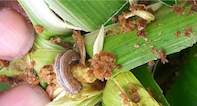Fall armyworm is a native of Central and South America that feeds on leaves and stems of more than eighty plant species, causing major damages to maize, rice, sorghum, sugarcane and other vegetable crops.
The pest was observed in Africa for the first time in 2016, in the rainforest zone of Western Nigeria and in maize fields at the International Institute of Tropical Agriculture at Ibadan and Ikenne. From there fall armyworm spread to other African countries and hit South Africa in 2017, with the first positive identification of larvae being made in January that year on a farm near Settlers in Limpopo.
The fall armyworm species mainly attacked yellow maize varieties, but also sorghum, sweet corn and potatoes. Most of the damage is caused during the larval stage, with the larvae feeding on the leaves during any stage of development, but primarily before maize plants have silked. According to Dr Annemie Erasmus of the Agricultural Research Centre – Grain Crops, the newly hatched larvae is green, but changes colour to either light tan, green or near-black as it gets older. The larvae are smooth skinned and have three yellow-white lines running down their backs, with a wider dark stripe next to the yellow lines on their sides.
Fall armyworm are distinguishable by the predominant Y-shape that runs on their foreheads between their eyes. Under favourable conditions, the larvae may start spinning a cocoon with soil particles and silk to pupate in, within fourteen days. Pupation normally takes place in the soil, but may also take place in leaf debris if the soil is too hard. Moths usually emerge eight to ten days later.
The moths have a wingspan of 32 mm to 40 mm, with both sexes having silver-white hind wings. The forewings of the males are in shades of grey and brown with triangular white spots at the tip and near the centre of the wing, while those of the females are less distinctive, according to Dr Erasmus.
Eggs are lain in batches of 100 to 200 that are attached to foliage. The eggs are dome- shaped with a flat base and curves upward to a rounded point. The female deposits a layer of greyish scales over the eggs batch, which appear furry. It takes between two to three days, depending on climatic conditions for the larvae to hatch.
Fall armyworm is extremely difficult to control with current insecticides only working on the larvae while they are small. Early detection and proper timing of application is therefore very important.

